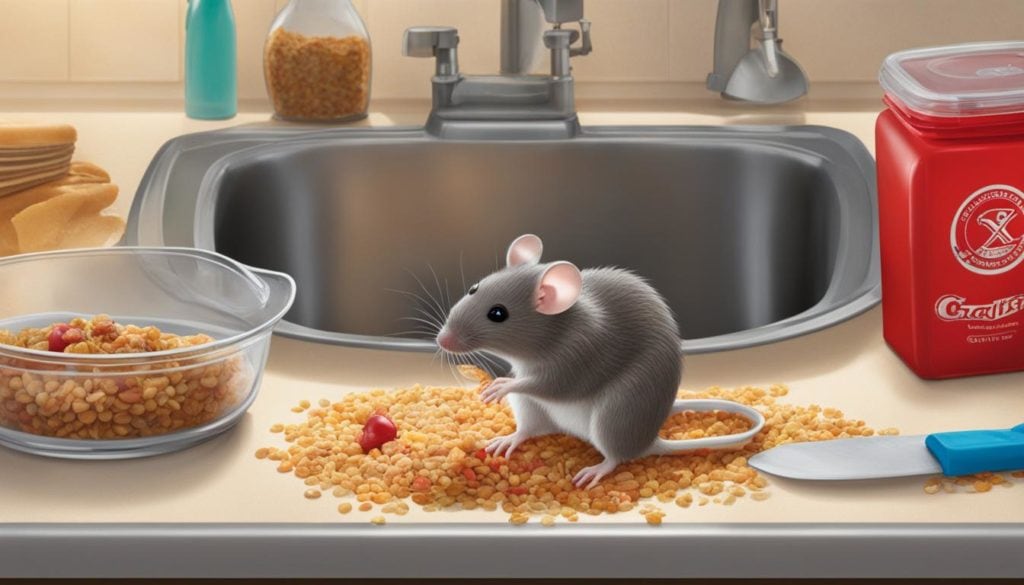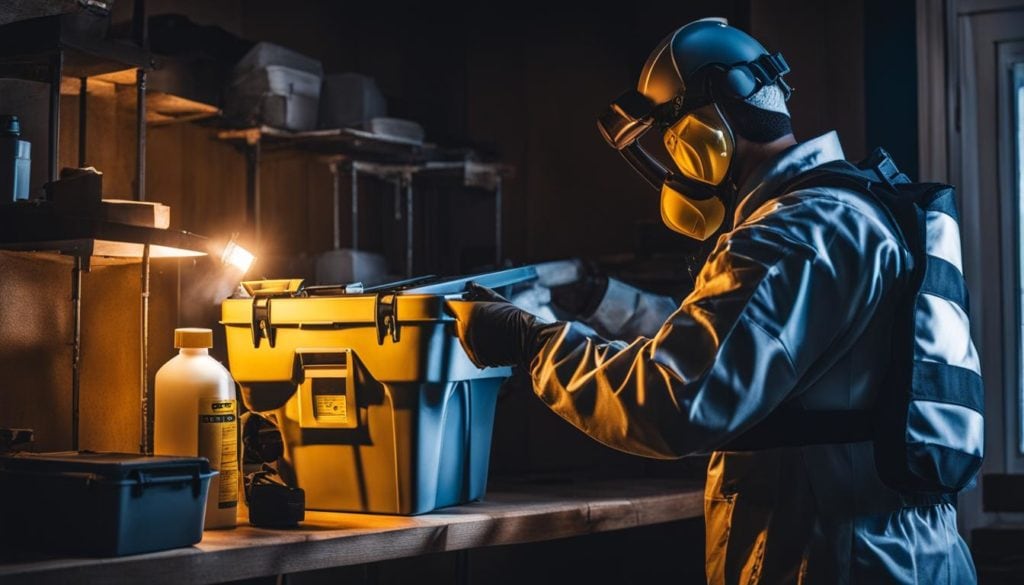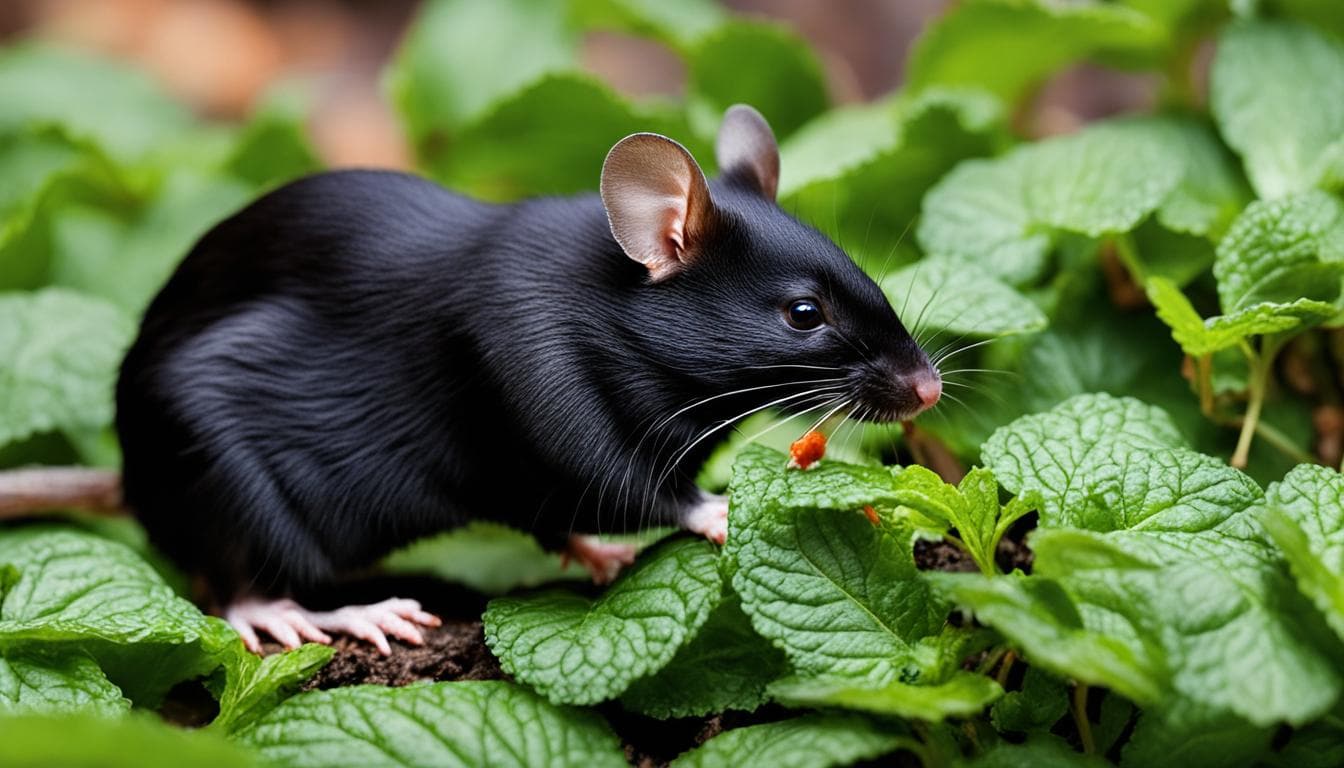Dealing with mice and rats in your home can be a frustrating and concerning issue. Not only do they pose health risks, but they can also cause damage to your property. It’s important to address the problem as soon as possible to prevent further infestations. In this comprehensive guide, I will share effective methods and techniques to get rid of mice and rats, including natural remedies, the best traps, and when to hire professional pest control services.
Key Takeaways:
- Identifying early signs of a mice and rat infestation is the first step to addressing the issue.
- Preventing access to food sources is essential in deterring mice and rats.
- Sealing entry points and utilizing traps are effective in eliminating rodents.
- Consider professional pest control services for severe or persistent infestations.
- Following safety guidelines and taking necessary precautions when dealing with rodents is crucial.
Identifying if You Have a Rodent Infestation
One of the first steps in eliminating mice and rats is identifying if you have an infestation. These pesky rodents often leave behind telltale signs that can help you determine their presence in your home.
- Mouse and Rat Droppings: Look for small, pellet-like droppings in areas where rodents are likely to be active, such as pantry shelves, cupboards, or under sinks.
- Gnaw Marks: Check for gnaw marks on furniture, electrical cables, or wooden structures. Rodents have sharp front teeth that continuously grow, so they need to gnaw on objects to file them down.
- Strange Noises: Listen for scratching, squeaking, or scampering sounds coming from the walls, ceilings, or hidden spaces in your home, especially at night.
- Holes in the Walls: Inspect the walls for small holes or gaps that could serve as entry points for mice and rats.
- Offensive Odor: Pay attention to unpleasant, musty smells in certain areas of your home, as rodents often leave behind an offensive odor from their urine and droppings.
- Footprints: Dust areas suspected of rodent activity with a thin layer of flour or talc powder and look for footprints.
- Nesting Areas: Search for nests made from shredded materials like paper, fabric, or insulation in attic spaces, crawlspaces, or hidden corners of your home.
If you notice any combination of these signs, it is likely that you have a mice or rat infestation that needs to be addressed promptly.
Remember, early detection and intervention can prevent the infestation from worsening and causing more damage to your property.
To help you visualize these signs, here’s an illustrative table:
| Signs of Mice and Rat Infestations | Description |
|---|---|
| Mouse and Rat Droppings | Small, pellet-like droppings found in areas of rodent activity. |
| Gnaw Marks | Visible marks and damage on furniture, cables, or structural materials caused by rodent chewing. |
| Strange Noises | Hearing scratching, squeaking, or scampering sounds, especially at night. |
| Holes in the Walls | Small holes or gaps in the walls that rodents use as entry points. |
| Offensive Odor | Unpleasant, musty smell resulting from rodent urine and droppings. |
| Footprints | Dust areas with flour or talc powder to reveal rodent footprints. |
| Nesting Areas | Shredded materials used to create nests in hidden corners of your home. |
Removing Food Sources for Mice and Rats

Mice and rats are always on the lookout for easily accessible food sources in your home. To prevent infestations and keep these unwanted guests away, it’s crucial to take steps to eliminate their food supply. Here are some effective measures you can take:
- Keep counters and floors clean: Regularly wipe down countertops and sweep or vacuum the floors to remove any food crumbs or spills that might attract rodents.
- Store food in chew-proof containers: Transfer food items from their original packaging to containers with secure lids. Opt for sturdy, chew-proof containers that mice and rats can’t easily gnaw through.
- Remove pet food overnight: If you have pets, avoid leaving their food out overnight. Instead, establish a feeding schedule and remove any uneaten food before going to bed.
- Take out garbage regularly: Dispose of your household garbage in sealed trash bags and take it out to the curb on a regular basis. Avoid leaving trash bags sitting inside your home for an extended period.
- Inspect pantry for gnaw marks: Regularly check your pantry for any signs of gnaw marks on food packaging. If you spot such marks, discard the affected items and thoroughly clean the area.
- Check under kitchen appliances: Mice and rats can hide and forage for food in the spaces underneath your kitchen appliances. Periodically move these appliances and clean the areas to remove any food debris.
- Pick ripe fruit and vegetables: If you have fruit trees or a vegetable garden, be sure to harvest ripe produce promptly. Overripe fruits and vegetables can easily attract rodents.
By implementing these preventive measures and removing potential food sources, you can significantly reduce the risk of mice and rat infestations in your home.
Testimonial:
“Since I started following these food removal practices, I haven’t seen a single mouse in my kitchen. It’s a relief knowing that my home is rodent-free!” – Sarah, Boston
Sealing Entry Points and Using Traps
Preventing mice and rats from entering your home is crucial in effectively eliminating them. To achieve this, it’s important to seal entry points using the right materials. Weather stripping, copper mesh, caulk, and expanding spray foam are effective options to seal gaps and cracks that rodents can use to gain access to your home.
Once you’ve sealed the entry points, it’s time to employ traps to capture and eliminate mice and rats. There are several types of traps available, each with their own advantages:
- Snap traps: These classic traps are designed to quickly and humanely kill rodents upon activation.
- Glue boards: Sticky surfaces trap and immobilize rodents, making them easy to dispose of.
- Live catch traps: These traps allow you to safely capture rodents alive, so they can be released outside later.
- Electronic traps: These traps deliver a lethal electric shock to the rodent, ensuring a quick and humane kill.
When setting traps, place them in areas where you’ve noticed rodent activity, such as along walls, near entry points, or in secluded areas. Remember to use bait to attract mice and rats to the traps, such as peanut butter or bits of cheese. Additionally, check the traps regularly and dispose of captured rodents promptly to maintain cleanliness and prevent any health hazards.
Tip:
If you’re unsure about the most effective placement of traps or need assistance, it’s a good idea to consult with a professional pest control service. They have the expertise to assess your specific situation and provide tailored advice to address the rodent infestation.
Hiring Professional Pest Control

For difficult infestations or for peace of mind, consider hiring professional pest control services. Exterminators who specialize in professional pest control for mice and rats have the expertise and tools to effectively eliminate these pests from your home. Here are the essential services that professional exterminators offer:
Inspection
Professional exterminators will conduct a thorough inspection of your home to identify the extent of the infestation. They will examine all potential hiding spots, access points, and nesting areas to develop a targeted treatment plan.
Bait Stations and Rodenticide Poisons
Exterminators use bait stations strategically placed around your home to attract and eliminate mice and rats. These stations contain rodenticide poisons that are designed to be enticing to rodents, ensuring their effectiveness in eradicating the infestation.
Sealing Entryways
To prevent future infestations, professional pest control technicians will seal entryways that mice and rats may use to access your home. They will identify and close off potential gaps, cracks, and openings, denying rodents any means of entry into your living space.
Follow-Up Appointments
Professional pest control services typically include follow-up appointments to ensure the effectiveness of the treatment. During these appointments, exterminators will assess the progress of the eradication process, make any necessary adjustments to the treatment plan, and address any new concerns that may arise.
Preventative Care
Beyond eradication, professional pest control services offer preventative care to keep your home rodent-free in the long run. They may provide recommendations on proper sanitation practices, offer advice on managing potential attractants, and suggest ongoing maintenance measures to minimize the likelihood of future infestations.
By enlisting the help of professional exterminators, you can have peace of mind knowing that your home is in the hands of experts who will employ targeted solutions to eliminate mice and rats effectively. Additionally, their expertise in sealing entryways and providing preventative care will help ensure that you aren’t faced with a recurring rodent problem.
When it comes to a professional pest control for mice and rats, leaving the job in the hands of experts is often the best course of action. Their knowledge, experience, and access to effective treatments and strategies make them the ideal solution for challenging rodent infestations.
Conclusion
Eliminating mice and rats from your home is crucial for maintaining a pest-free and safe environment. By following the effective methods and tips mentioned in this guide, you can successfully get rid of these rodents and prevent future infestations.
To summarize, start by identifying signs of infestation, such as droppings, gnaw marks, strange noises, and nesting areas. Next, remove food sources by keeping counters and floors clean, storing food in chew-proof containers, and removing pet food overnight. Additionally, seal entry points using materials like weather stripping and caulk, and utilize traps such as snap traps and glue boards to eliminate rodents.
While DIY methods can work, it is important to recognize that severe or persistent infestations may require professional help from a pest control company. They have the knowledge and tools to effectively inspect your home, use bait stations and rodenticide poisons, and provide follow-up appointments and preventative care.
Remember, always take the necessary precautions and follow safety guidelines when dealing with mice and rats. By implementing these final tips and recommendations, you can achieve a rodent-free home and enjoy peace of mind.
FAQ
How can I tell if I have a mouse or rat infestation?
Look for signs such as droppings, gnaw marks, strange noises, holes in the walls, offensive odor, footprints, and nesting areas.
What can I do to prevent mice and rat infestations?
Keep your counters and floors clean, store food in chew-proof containers, remove pet food overnight, take out garbage regularly, inspect the pantry for gnaw marks, check under kitchen appliances, and pick ripe fruit and vegetables.
What are the best traps for mice and rats?
Some effective traps include snap traps, glue boards, live catch traps, and electronic traps.
How do I seal entry points to prevent mice and rats from entering my home?
Use materials like weather stripping, copper mesh, caulk, and expanding spray foam to seal entry points.
Should I hire professional pest control services for mice and rats?
Hiring professional pest control can be beneficial for difficult infestations or for peace of mind. Exterminators can conduct a thorough inspection, use bait stations and rodenticide poisons, seal entryways, provide follow-up appointments, and offer preventative care.
Do I need professional help to eliminate mice and rats?
While DIY methods can be effective, severe or persistent infestations may require the assistance of a professional pest control company.
Source Links
- https://www.bigbluebug.com/blog/post/the-ultimate-guide-to-mouse-removal-keep-your-connecticut-home-safe-and-clean
- https://www.actionpest.com/blog/post/the-ultimate-guide-in-making-your-home-unattractive-to-rodents
- https://todayshomeowner.com/pest-control/rodents/

Welcome to micegoneguide.com, your go-to resource for eliminating rats and mice. Say goodbye to rodent infestations with our expert tips and strategies. Visit us now and reclaim your space!

